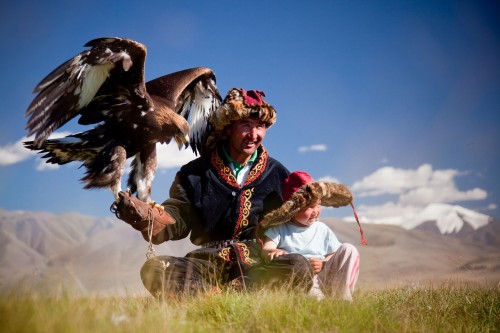
For use in a Dungeons & Dragons setting largely devoid of “monstrous humanoid” races. Due to a surplus of civilized noble races in the Player’s Handbook, half have been designated as less-civilized exotic people to fill the role of the menacing Other.
Before the first foundation stone was laid on Burkant Hill, before the sedentary folk of Cach or Abadan set sail to clear the forests and terrace the hills and harness the rivers, the lands were already long peopled. Four great tribes have lived here since the gods first set the sun and moon alight. They are people slow to change but quick to move on, abiding by ancient traditions. The sedentary folk of the cities erect their walls and think themselves civilized, building their society around stone and industry and coercion. The Great Peoples, though they vary greatly in their appearance and history and particular customs, build theirs upon family, honor, and hospitality, pillars far more durable.
Each of the Peoples organize themselves very loosely, largely by extended family, with no formal governments at all. Trade is largely done with neither currency nor barter, with most goods trading hands in the form of gifts between households and an informal credit and debt system. Between different Peoples and the sedentary folk barter and coin are common. Raiding between Peoples and families for livestock, goods, and women is common enough to form a continuous tradition of warrior culture stretching back thousands of years. Rarely these raids escalate to full-blown wars over territory. Casualties are typically minor, as the Peoples have nomadic tendencies and will generally withdraw when faced with overwhelming odds. In this way their lands have been gradually ceded in the face of the city-builders.
The names for each of the Peoples here are those used for diplomatic and legal purposes in Cach. Each has its own language, in which the word for themselves is translated roughly to “the true people” or “the great people.”
Dragonborn
The Dragonborn range primarily to the South, migrating North in the late spring to bring their herds out of the parched savanna, then returning just after the monsoons pass. They are perhaps the most exotic of the Peoples, dwelling briefly and rarely encamping in one place for more than a week. They tend to flocks of domesticated drakes, and often have access to goods hailing from distant lands. Their prolonged absences from territory they consider theirs can lead to misunderstandings and friction with homesteaders and expansionist city-builders. Dragonborn men and women dress very conservatively, veiling themselves when visiting or entertaining outsiders. They segregate between genders almost continuously.
Elves
The Elves hold a large portion of the Northern lands, dwelling in the forests and hills. Not as nomadic as the Dragonborn, not as settled as the Gnomes, Elven families move their homes to follow the growing cycle of plants they cultivate, sowing crops one season then leaving for months at a time before returning. A typical Elven family will rotate between five or six locations over a cycle of three years. They sometimes keep horses, but are most famous for their tame elk, which their warriors ride on raids but are never used for plowing.
Gnomes
Gnomes are the most settled of the Peoples. It is thought they were once city-builders themselves, or were wholly subjugated to some long-lost city-building race. Their oral tradition tells of a great immortal tyrant that was slain, his temple ruined and his followers put to the axe. The location of such a temple is unknown, for the Gnomes have lived in small mountain villages for as long as any other People can remember. Gnomish families are reckoned matrilineally and raiding for brides is rare. Gnomish settlements are strongly averse to interacting with other Peoples or city-building folk. Whenever the location of one of their villages is known to non-Gnomes, the people will almost immediately take up the debate to either silence the interlopers or move. Approaching a Gnomish settlement is extremely hazardous. Gnomes subsist on hunting, gathering, and small-scale gardening.
Orcs
These are the most physically imposing and least refined of the Peoples, in the eyes of city-builders. Raids between Orcish families are common, and trade with them is somewhat hazardous, as they have a long history of deciding (after the fact) that they have been cheated or disrespected in some way by a deal. This often leads to a surprising retaliatory attack, with dozens of fearsome Orcs on their Terror Birds pouring out of the hills, howling as if possessed. The Orcish diet relies heavily on hunting, supplemented by foraged vegetation. The needlework on Orcish textiles is world-reknown, with many brave merchants having made fortunes and lost their lives trading dyes and thread to secure samples for wealthy patrons.
Orcs as presented here use the rules for Half-Orcs found in the Player’s Handbook. Their Terror Birds are Axebeaks, as presented in the Monster Manual. Subraces are considered part of the same tribe, though of different family lineage.